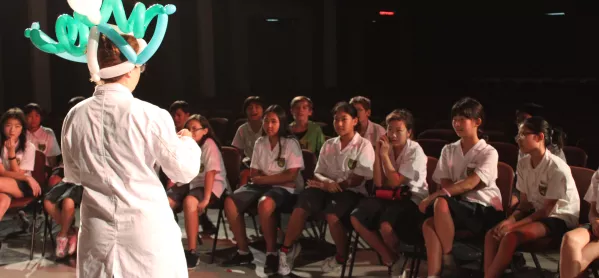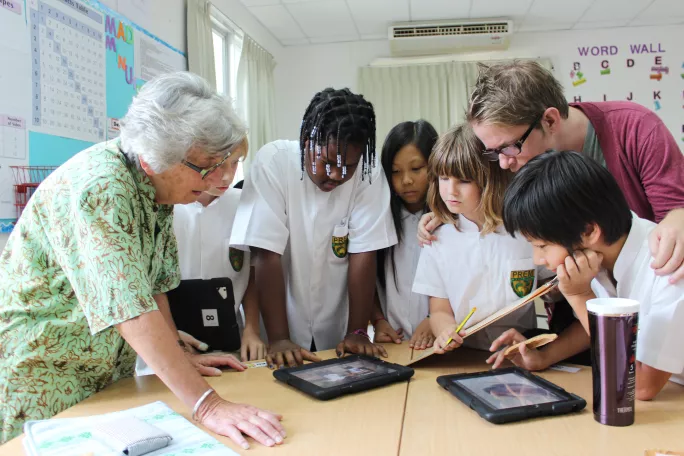How in-school artists helped boost creativity

As was the case for many in education, Sir Ken Robinson’s death last year hit me hard.
His message regarding the importance of creativity in schools, and of recognising and cultivating individual talents, still resonates with those who remain committed to the grassroots revolution he inspired.
Yet finding practical, effective ways to engender creativity in schools can be as challenging as it is rewarding.
However, after several years of working at an international school doing just this, I believe there are ways we can achieve it - and in such a way as to have a meaningful impact on the teaching and learning that takes place.
The models we have used are based on ideas I had explored while working in the UK arts and cultural sector as an education and creative projects manager, but I think any school could learn from.
Education and the arts in harmony
To start, a question: how often have you noticed during a trip to a gallery, museum or other arts and culture centre that they have a dedicated educational outreach function?
The needs of schools are key considerations when a theatre, museum or gallery produce or present new work, and it’s not uncommon for the educational and community offer to be as carefully considered as the artistic one.
This realisation, alongside Sir Ken’s philosophy concerning creativity, were key to my decision to accept a role at Prem Tinsulanonda International School and Traidhos Three-Generation Community for Learning with the remit to develop “education for creativity” across the school, curriculum and wider community.
As I began the role, I asked myself what would happen if we replicated the approach that I had witnessed in the UK. Was there a way to embed a professional arts organisation into the centre of a school?
This question prompted more: what tangible benefits and what particular learning might happen if you merge the ideas and approaches of artists, creative practitioners and creative thinkers, with those of teachers, educational leaders and young people?
To find answers to these questions, a creativity committee was formed and, from this, a bold idea was conceived.
We would create our own developmental learning laboratory that sits at the centre of the school, integrating the practice of participants into teaching, learning and community engagement. We named it Artist Residency Thailand.
The concept could easily have been rejected had I not been able to point towards data collected while working with organisations such as Artswork and campaigns I had conceived that had been fronted by Sir Ken.
With backing from the top, we could begin.
The overarching idea was to create a vehicle with which to drive the centralising of creativity across the school and wider organisation. To support the costs involved, we established a partnership with ISTA (The International Schools Theatre Association) and accredited the programme through Res Artis, a worldwide network of arts residencies.
What started with a handful of applications in the first year grew to nearly 400 in its fifth. Pre-Covid, we spent every April and May discussing approaches and ideas with practitioners, department heads, programme leaders and the leadership team, and then welcomed selected participants for eight residencies throughout each following academic year.
All programme participants give an average of four hours of their time each day to work with our community and, in return, they benefit from resource access, opportunities for piloting ideas and mentoring, as well as research, exhibition and performance spaces.
Meanwhile, we benefit from their ideas, approaches, expertise and creative energy.

From philosophers in junior school classrooms and ceramicists in science labs, to theatre directors in English lessons and conceptual artists in early years classrooms, the programme provides a plethora of learning lenses, benefiting educators, students and the wider school community.
Each residency is different and participants deliver everything from stand-alone masterclasses or seminars to month-long engagements that are driven by project-based learning.
Often, participants hold events, debates, concerts and performances, framing the school and campus as a cultural hub for the wider community.
There are practical exchanges, too. The school offers housing and transport, pastoral care, marketing, networking and mentoring opportunities for all participants.
To strategically manage this work, a new leadership role of creative director was developed, working in partnership with the head of school and the chief executive to help ensure the projects chosen effectively develop the school’s creative vision.
Essential in helping focus this vision and ensuring meaningful engagement for students, we introduced four guiding principles that practitioners and teachers alike can use to inform their approaches:
- Engage: Get students excited about their learning.
- Enhance: Go beyond what we have done before.
- Enliven: animate our campus and community with learning and expression and make learning visible .
- Empower: Develop resilient and confident young people and progressive, open-minded educators.
Over the past eight years, these approaches have created impactful learning experiences for students, invaluable professional development opportunities for staff and inspiring cultural engagements for our community.
Our students are now more likely to see their learning taking place in different and unusual areas of our campus,; interdisciplinary and transdisciplinary approaches are more imaginative and collaborative in nature; and our educators are more confident borrowing lenses and connections introduced by practitioners.

Staff have benefited from professional development that has included artists from ISTA and other programme participants. Many “non-arts” subject teachers now have an understanding of arts-centralised skills that can be used to aid inquiry or manage energy levels within all subject areas.
Screenings by filmmakers, seminars from philosophers and concerts from indie-pop musicians have brought our community together outside of the classroom and work explored, developed and started here has been performed, shared and celebrated internationally.
Managing this process has shown that there are practical ways to nurture creativity in our schools and create the kind of grass-roots transformation that Sir Ken inspired so many to begin.
As he stated: “A vibrant school can nourish a whole community by becoming a source of hope and creative energy.”
I believe what we have piloted demonstrates that there are practical ways to achieve that and very good reasons for others to explore similar approaches.
Alex Soulsby is a creative education specialist and the creative director for Prem Tinsulanonda International School and its Artist Residency Thailand programme
Register with Tes and you can read two free articles every month plus you'll have access to our range of award-winning newsletters.
Keep reading with our special offer!
You’ve reached your limit of free articles this month.
- Unlimited access to all Tes magazine content
- Save your favourite articles and gift them to your colleagues
- Exclusive subscriber-only stories
- Over 200,000 archived articles
- Unlimited access to all Tes magazine content
- Save your favourite articles and gift them to your colleagues
- Exclusive subscriber-only stories
- Over 200,000 archived articles